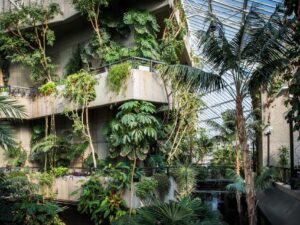Textiles. Polystyrene cups. Television sets. Rubber. Lightbulbs. Rocks. This selection of large-scale group exhibitions for 2024 shows how almost anything can be a used as a material for creative expression. It surveys 20th and 21st century approaches to sculpture, revealing how, in the hands of experimental artists, everyday objects can become subversive tools for making bold statements about the world.
When Forms Come Alive | Hayward Gallery, London
7 February – 6 May
The definition of “contemporary sculpture” has changed a lot over the past 60 years. Today, it encompasses everything from hard-carved marble and wood to room-sized installations and immersive digital experiences. Hayward Gallery ties all these approaches together under the umbrella of “movement, flux and organic growth.” Inspired by sources ranging from a dancer’s gesture to the breaking of a wave, from a flow of molten metal to the interlacing of a spider’s web, the artworks in When Forms Come Alive undulate, droop, erupt and cascade. In an era when our encounters are increasingly digitised and disembodied, these artworks invite us to be physically present. They remind us that nothing in the world stays the same, that everything is moving, seething, changing and transforming. The show features Ruth Asawa; Nairy Baghramian; Phyllida Barlow; Lynda Benglis; Michel Blazy; Paloma Bosquê; Olaf Brzeski; Choi Jeong Hwa; Tara Donovan; DRIFT; Eva Fàbregas; Holly Hendry; EJ Hill; Marguerite Humeau; Jean-Luc Moulène; Senga Nengudi; Ernesto Neto; Martin Puryear; Matthew Ronay; Teresa Solar Abboud and Franz West.

Only the Young: Experimental Art in Korea, 1960s–1970s | Hammer Museum, Los Angeles
11 February – 12 May
In the decades following the Korean War (1950–1953), creatives began to take a stance against what they saw as a limiting approach to art-making. Instead, the 1960s and 1970s saw them embrace innovative – and often provocative – processes, founded on ideals of experimentation, breaking with the past and a critical, self-reflective lens. Only the Young features some of South Korea’s earliest and most emblematic explorations into assemblage, installation, happenings and conceptual artmaking, as well as works that use industrial materials and new technologies. Together, they capture a pioneering and lesser-known moment in Korea’s cultural history – a time when creative willpower and the pursuit of experimentation were transformed into tools for grappling with a newly formed republic, contending with its authoritarian regime, rapid pace of industrialisation and an influx of cultural influences from overseas.


Melencolia | Galerie Eva Presenhuber, Zürich (above left)
Until 24 February
Melancholy is defined as “a feeling of pensive sadness, typically with no obvious cause”, and can be traced back to the 14th century. Several hundred years later, we find its meaning virtually unchanged. Now, it’s the theme of a contemporary art exhibition including disquieting sculptural forms by Franz West – his “incarnations of neurosis” – as well as eerie masks from Ugo Rondinone. There is an intricate tapestry by Athi-Patra Ruga, an artist known for engaging with the wounds of colonial history, curated alongside bright depictions of queer Black love from Jonathan Lyndon Chase. Both artists are dedicated to subverting canonical misrepresentations of Black bodies. Elsewhere, Liesl Raff creates suspended rubber sculptures that make us look twice. Perhaps most striking are the enigmatic paintings of Louisa Gagliardi, which pull the viewer towards red, strobe-lit rooms populated by perspex chairs and strange, out-of-place fruits. There’s a Bacon-meets-Dalí feel to the work. What Melencolia shows is how feelings – however bleak – connect us across time and borders. Together, these works – of different media, from all over the world – come together in a meticulous and thoughtfully put together exhibition, compelling in its pervasive unease.
Beyond Form: Lines of Abstraction, 1950 – 1970 | Turner Contemporary, Margate (above right)
3 February – 6 May
Turner Contemporary, meanwhile, takes post-WWII as its starting point. During the two decades after the war, abstraction began to grow in popularity as a visual language, especially amongst women artists. By pushing the boundaries of different forms, materials and modes, these practitioners were making sense of the seismic cultural, social and political shifts unfolding around them. Beyond Form, comprising over 80 artworks, traces how the language of abstraction developed on a global scale from 1950-1970. It will include sculptures by Carla Accardi; Novera Ahmed; Ruth Asawa; Maria Bartuszová; Lynda Benglis; Louise Bourgeois; Maria Theresa Chojnacka; Lygia Clark; Saloua Raouda Choucair; Sue Fuller; Eva Hesse; Marisa Merz; Yuko Nasaka; Louise Nevelson; Mona Saudi; Lenore Tawney; Hedda Sterne, and Hannah Wilke.

Unravel: The Power and Politics of Textiles in Art | Barbican, London
13 February – 26 May
“Textiles cover and protect us, engage our senses, trigger our memories, represent our beliefs, hold our stories. We are wrapped in cloth when we’re born and enshrouded in it when we die.” Barbican shows us how, using textiles, fibre and thread, 50 international artists have challenged – and continue to challenge – power structures around the world. In this major group exhibition, intergenerational artists use textiles to communicate vital ideas about power, resistance and survival. From intimate hand-crafted pieces to monumental sculptural installations, these works – by Magdalena Abakanowicz, Faith Ringgold, Cecilia Vicuña and more – speak of violence, imperialism and exclusion, all well as resilience, love and hope.
Image Credits:
1. Tara Donovan, Untitled (Mylar) 2011/2018 Mylar and hot glue Dimensions Variable Installation view, MCA Denver Photo: Christopher Burke Courtesy the artist and Pace Gallery.
2. Park Hyunki, Untitled (TV Stone Tower), 1982. Color video (silent), CRT monitor, stones, dimensions variable. Image courtesy of the artist and the Guggenheim Abu Dhabi.
3. Liesl Raff, Blind (Yellow), 2023. Courtesy the artist and Galerie Eva Presenhuber, Zurich / Vienna.
4. Louise Nevelson, Royal Tide III, 1961, Wood painted gold, 223.8 x 162.6 x 30.5 cm, Private Collection, London, © ARS, NY and DACS London 2023.
5. Solange Pessoa, Hammock (part of 4 Hammocks), 1999-2003. Courtesy of Rubell Museum, Miami and Washington DC. Photo: Chi Lam.




